Our dogs both go to groomers to get a full haircut and spa treatment but in between those visits we wash them at home. However, we still try and provide a bit of a ‘spa’ experience by having the right tools and accessories at hand. So we thought we would run through some of our top tips for giving your dog a great wash at home!
1. Have the right tools and have them at hand
Before you’re up to your armpits in soap suds take a second to locate all your tools, shampoos, conditioners and towels so you can reach them without leaving your dog (who will take any opportunity to run off and shake water all over the couch). A sample dog bath kit might include shampoo, conditioner, towel(s), combs, brushes, scissors, a lead, gloves, treats, cotton buds, a spare plastic bottle and baby wipes. Depending on your dog’s coat you might add dematting and shedding tools. It is a great idea to have a ‘spa kit’ that keeps all your dog washing items together. Then you can get underway quickly and know what you need to replace afterwards.
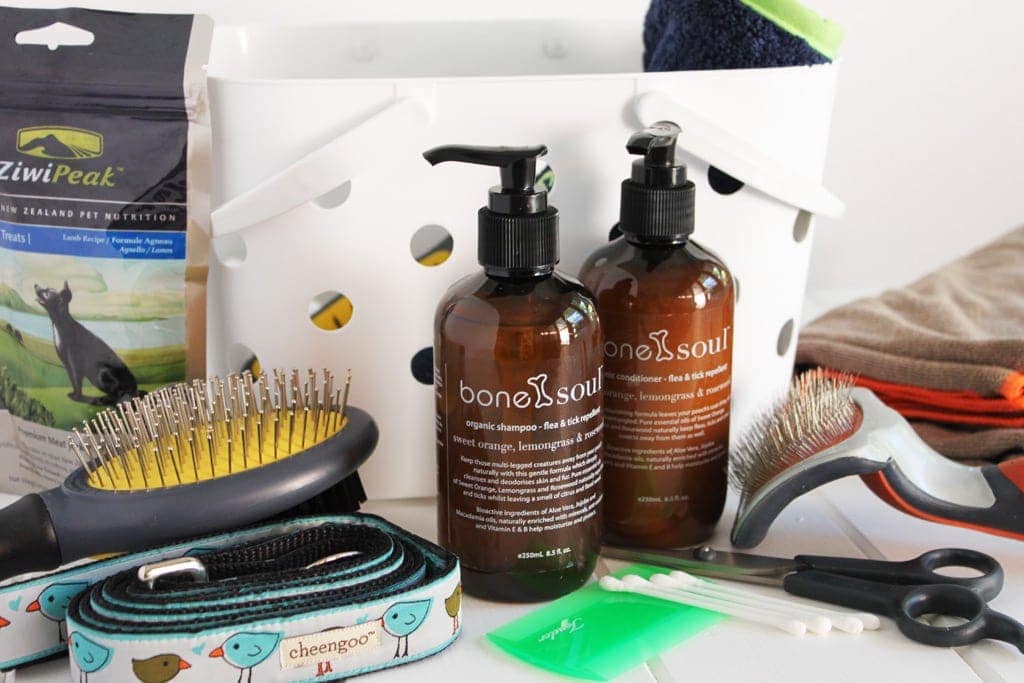 A sample dog bath kit might include shampoo, conditioner, towel(s), combs, brushes, scissors, a lead, treats, and cotton buds.
A sample dog bath kit might include shampoo, conditioner, towel(s), combs, brushes, scissors, a lead, treats, and cotton buds.
2. Restrain your dog
Most dogs I have known don’t willingly have a bath, Cress and Eddie included. Some dogs need just a little encouragement and some, well, need to be carried to their doom. So depending on your dog you will know if they need to be tied up before you even whisper the word ‘bath’. Depending on your bath spot this is when a lead will come in handy. Cress is somehow able to detect the slightest of our bath-related thoughts, so if we don’t lock him in the bathroom early he will hide behind the bushes at the bottom of the yard and have to be carried out of his hiding spot. Once you begin, the collar and lead may no longer be required as long as you have your hands on them. If your dog really hates the experience try to spend a few minutes at the start cuddling or playing with them to help them relax.
Note: If you are washing your dog outside make sure you have some warm water in buckets or a small pool as no-one likes a freezing cold bath!
3. Shampooing your dog
Once you have the dog all nice and wet you will want to grab your shampoo and scrub-a-dub-dub! A little tip we have learnt over the years is that it is often better to dilute your shampoo slightly before you apply it. This is because it is a lot easier to rinse the shampoo from your dog’s coat afterwards and diluted shampoo penetrates thick fur better. So grab that spare plastic bottle we mentioned above, add some water and then add some shampoo and shake it up. Note: medicated shampoos often need to be used at full strength.
Apply the shampoo mixture to your wet dog’s neck and then work down their back, their sides, underneath their chest and stomach. Lather up the armpits, legs and paws. Finally lather the tail making sure you get underneath to clean your dog’s rear. This is where the plastic gloves come in handy just in case there are any little pieces of poo stuck in their fur! Then rinse WELL!
If you want to give your dog a super good clean or it has been a long time between washes go for a second shampoo to make sure you have got down to your dog’s skin. Rinse super well after each wash. Plus don’t forget to be very careful and not get shampoo in your dog’s eyes.
Like human shampoo there are a lot of options out there for your dog. So hunt around and choose based on their skin and coat needs.
4. Conditioning your dog
Lots of people use 2-in-1 shampoo/conditioner on their dogs and I totally understand why you want to cut down on bath time. However, most of us also know that for our own hair it is much better when we use a separate conditioner and the same is usually true for your dog. Like the shampoo you can choose to dilute it before you work it into your dog’s coat. This is the perfect time to grab the comb and run it through your dog’s coat. When your dog’s hair is wet it stretches so this is also a great time to loosen up matting by combing through the conditioner. Once conditioned rinse well again!
If your dog has very dry fur or hair make sure you have a moisturising conditioner. But another thing to think about if they have very dry fur is their diet — they may be missing some essential omega fatty acids. Fish oil can be added to your dog’s food but you may need to totally reassess what they are eating.
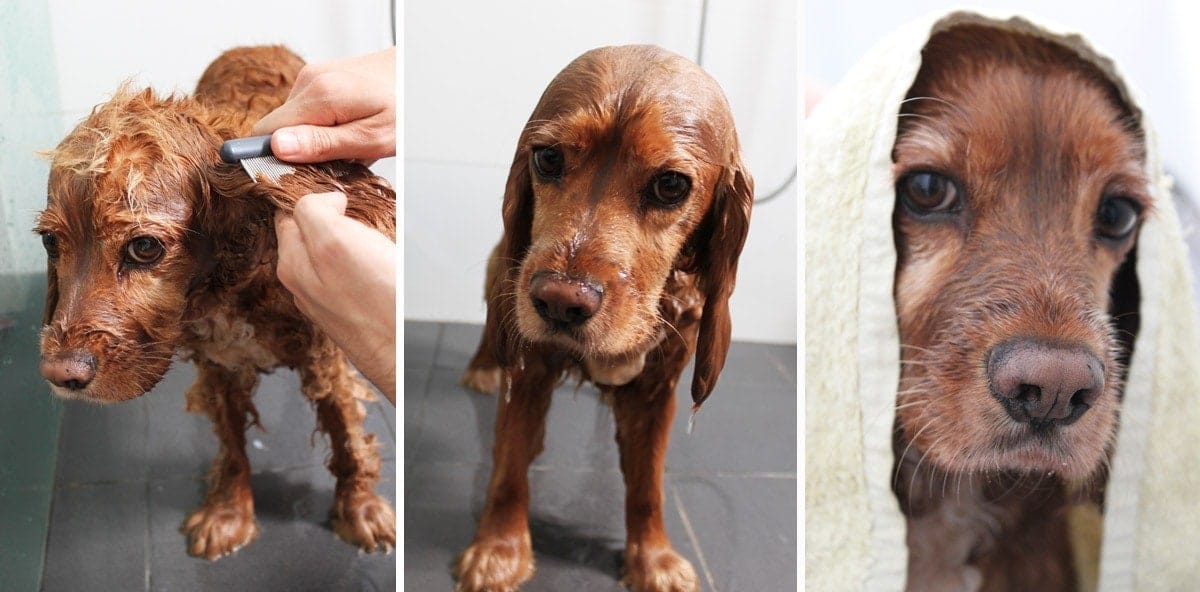 While conditioning it is the perfect time to grab the comb and run it through your dog’s coat. When your dog’s hair is wet it stretches. Once conditioned rinse well!
While conditioning it is the perfect time to grab the comb and run it through your dog’s coat. When your dog’s hair is wet it stretches. Once conditioned rinse well!
There are also a lot of dog conditioner options available so you can again choose based on their skin and coat needs. In the Puppy Tales Shop we have organic Flea and Tick Conditioner, Sensitive Conditioner, Super Shine Conditioner and Puppy Conditioner.
5. Checking for lumps, bumps, cuts and parasites
While shampooing and conditioning your dog this is the perfect time to check for any little lumps or bumps that they might have. You can discover things like cancerous tumors in the early stages or maybe a tick if you have just gotten home from an adventure. Especially during conditioning, use the time to check for any flea dirt or little cuts and scratches that you also may want to keep an eye on.
Cress had a small sebaceous cyst on one of his front legs which I picked up while bathing him and was able to ask the vet about it on our next visit.
6. Drying your dog
It is always good to start with a good towel-dry no matter what other tools you are going to use to dry your dog. If your dog has long hair don’t get too vigorous as this might tangle the hair. Obviously if you are outside let them have a quick shake but I try to prevent this from happening in my bathroom and they only get to do it once they have had a good pat down. We use several towels to wick up all the moisture, plus one for them to stand on.
If you’re lucky enough to have a dog who can stand the noise and you’re planning on using your hair-dryer then make sure you don’t have it set on high heat, as you can quickly burn your dog’s skin. It is best to keep it moving over their whole coat and only once they are close to being dry start any fluffing or straightening you might want to achieve.
Cress and Eddie both have long ears so I try and make sure the fur on the inside of these dries fairly quickly so it doesn’t create a humid environment for bacterial growth. If your dog has skin folds (Pugs, Bulldogs, Shar-Pei etc) these needs to be carefully cleaned and dried as well.
7. Ear clean and eye check
After your dog has had a good towel-dry it is the perfect time to check their ears and eyes to make sure they are healthy and clean. Check if the ears look red or inflamed, have a discharge or smell. If any of these are apparent in your dog then it looks like you need to take them to the vet. However, if their ears look good use a cotton bud to clean just around the ear flap (also called the Pinna). However, don’t put the cotton bud into their ear canal; you don’t want to cause any damage.
Check you dog’s eyes and carefully clean any muck away with a clean tissue or baby wipe. Some dogs develop reddish brown tear stains which can be a sign of eyelid disorders, so if you see this take your dog to the vet. Tear stains can’t be removed by a bath or a baby wipe. The hair needs to be cut or shaved out but it is probably best to get this done by a professional groomer. We all know eyes are delicate!
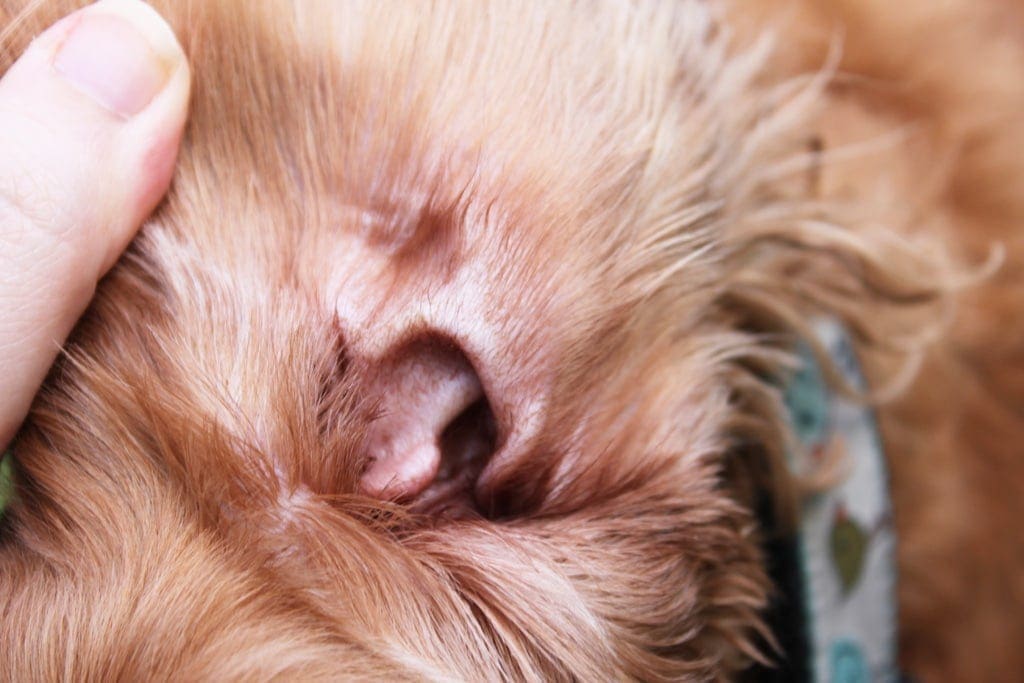 After washing your dog it is a great time to check their ears!
After washing your dog it is a great time to check their ears!
8. Brushing and a quick trim
Depending on your dog’s breed you will need to investigate what tools you may require to properly handle their coat-type, whether it be smooth, curly, long or wired. But here are some basic principles that can apply to brushing most dog’s coats.
Firstly, it is always best to start your brushing session with a wide toothed comb. Once this comb can travel easily through your pet’s hair you can move onto a comb or brush with narrower-set teeth. At any stage if you hit snags, knots and matting it is best to try and work these out with a slicker brush (designed to help remove mats while also pulling out dead hair and gently stimulating the skin). If you gradually move to a brush with closer-set teeth and eventually a flea comb it means you will get down to the dog’s skin and pull out any lingering dead hair and fleas if they are present. A little plastic flea comb is also great to use gently on your dog’s face.
If there are knots and matting that just won’t be brushed out this is the time to grab your scissors and very carefully cut away the tangles. It is also a great time to check your dog’s paw pads to make sure there is no mud, debris, parasites and grass seeds in between their toes. Due to friction in this area from walking and running lots of matting can occur which is very uncomfortable for a dog. Long fur that causes your dog’s toes to splay can also be uncomfortable. So grab your scissors and very carefully trim out any matting and neaten up their foot so the hair is short and neat.
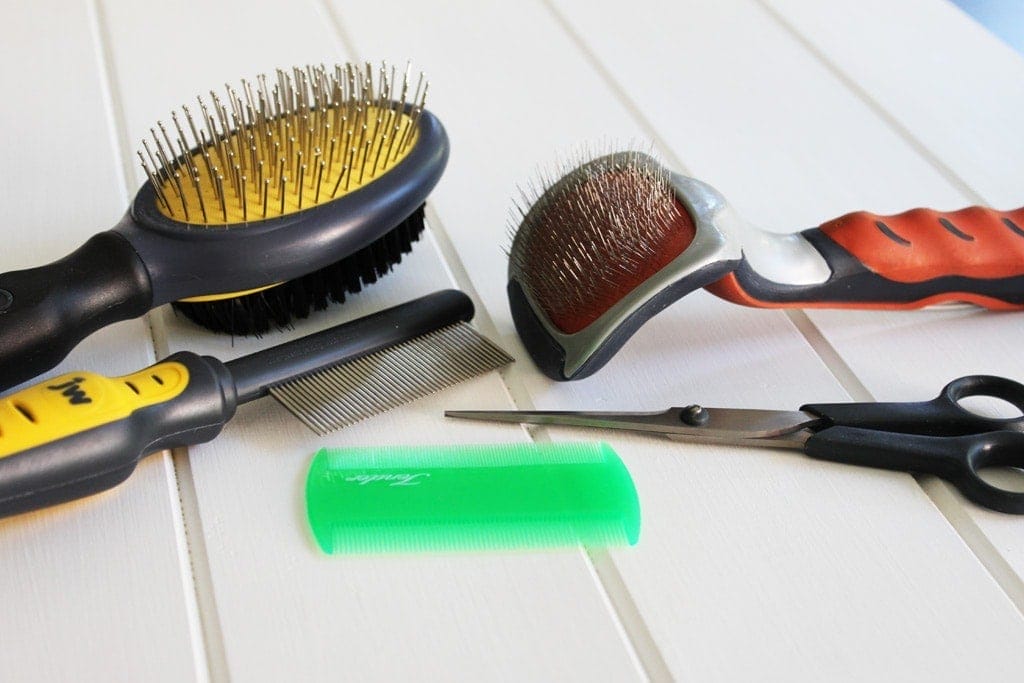 Different sorts of brushes, combs and scissors help groom your dog’s coat
Different sorts of brushes, combs and scissors help groom your dog’s coat
9. Nail care and anal glands
In our house nail care is left to the professional groomers or the vet. Some dogs don’t need their claws clipped if they do a lot of running on hard surfaces, but many dogs do. If you are keen to do this yourself you need to invest in dog clippers and learn where your’s dog’s quick ends as if you cut this it will be painful for your dog and there will be a lot of blood.
I also have no desire to express my dog’s anal glands as it smells terrible!! Therefore if you have any concern your dog may have infected or impacted anal glands I would take them to the vet. Symptoms of anal gland problems most often include scooting and licking of the rear end. However, if you do decide that you wish to empty your dog’s anal sacks yourself check with your vet on how to do this, as if you are not careful you could rupture them and cause your dog a lot of pain.
10. After bath check
You now have a lovely, clean and hopefully happy dog. This is a great time to give your pooch some extra hugs and treats for being so good, or at least getting through it. It is also good to watch your dog and check they don’t have a skin reaction — like rashes or hives — in response to any of the products you have used. If your dog is very itchy maybe consider using different products next time as they might have a slight allergy or their skin feels very dry.
Lastly put your grooming kit back together after everything has dried and make a note to replenish any shampoos or conditioners that are in short supply. It is annoying when you have a dirty dog but nothing to clean them with!
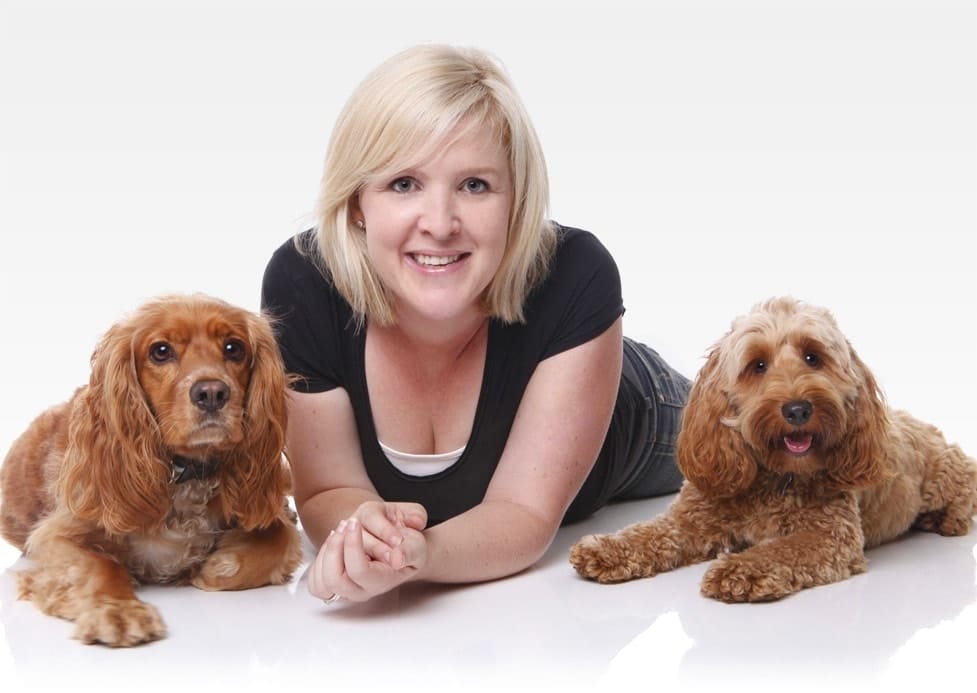
Lisa Miller
Lisa Miller is a blogger, digital strategist, business coach, zoologist and crazy dog-lady! Lisa lives in Sydney, Australia with her husband, two kids, two dogs and two cats. That equates to a lot of fun and vacuuming. Her dog’s names are Cresswell and Edwina (or Cress and Eddie).



